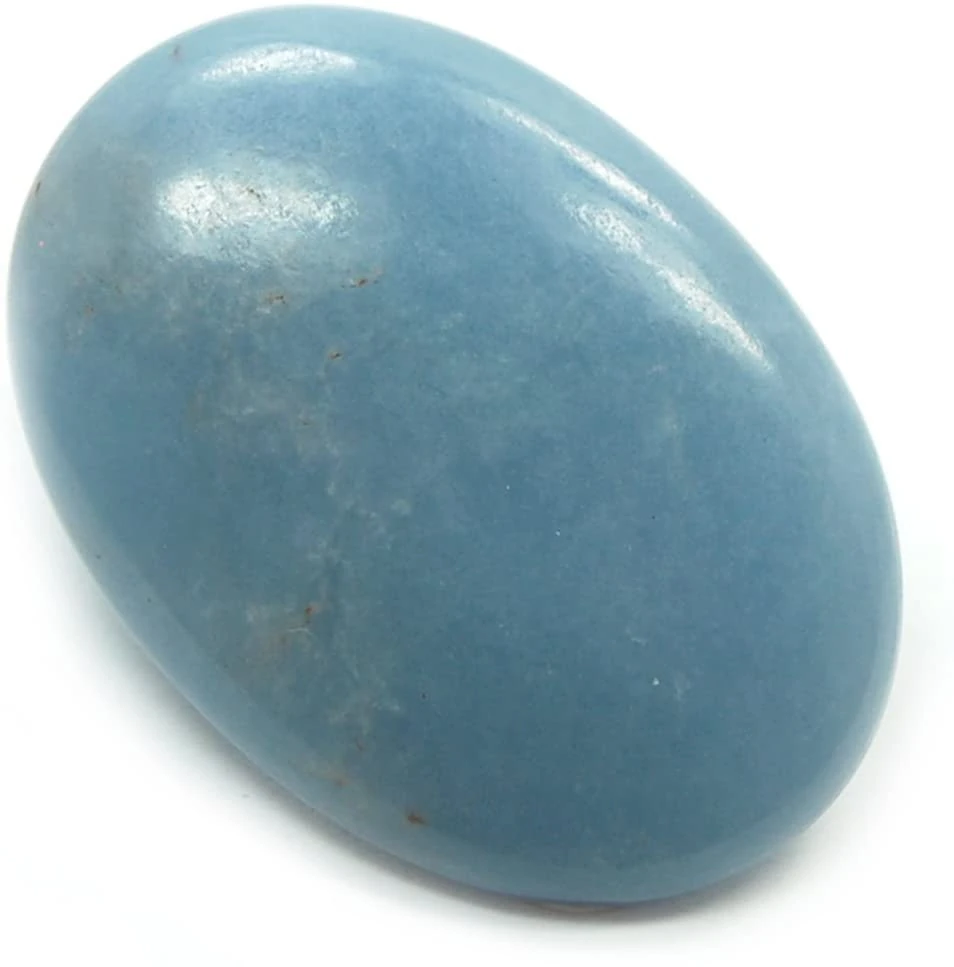
Angelite is the trade name for a blue variety of anhydrite, a mineral that lacks water in its structure. The name “Angelite” comes from its perceived spiritual properties, often associated with angelic communication and higher consciousness. Anhydrite itself derives from the Greek word anhydros, meaning “without water.” Alternative names for Angelite include Blue Anhydrite and Angel Stone.
Composition and Physical Characteristics
Angelite is a form of calcium sulfate (CaSO4) and is closely related to gypsum. Unlike gypsum, Angelite lacks water molecules, making it more compact and slightly harder.
Physical Properties:
- Colour: Pale to deep sky blue, sometimes with white, grey, or violet hues
- Hardness: 3 to 3.5 on the Mohs scale (relatively soft)
- Lustre: Waxy to pearly
- Transparency: Opaque to slightly translucent
- Cleavage: Perfect in three directions
- Formation: Forms in sedimentary basins where gypsum has lost its water content due to heat and pressure
Varieties of Angelite
Though primarily known for its pale blue colour, Angelite can sometimes exhibit shades of lavender or grey due to variations in mineral impurities.
Locations
Angelite is found in:
- Peru – The most significant source of high-quality blue Angelite
- Mexico – Produces fine blue and greyish specimens
- Germany – Known for lavender-tinged Angelite
- Poland – Contains minor deposits
- Libya and Egypt – Occasionally yield blue anhydrite specimens
Archaeological and Significant Finds
Angelite is not commonly associated with ancient civilisations, as its softness and solubility in water make it unsuitable for extensive use in artefacts. However, its parent mineral, anhydrite, has been found in geological studies of ancient sedimentary formations, particularly in evaporite deposits.
Historical and Current Usage
Angelite has not been historically prominent due to its softness, but it has gained popularity in the modern era for spiritual and decorative purposes.
Uses:
- Jewellery – Used in beads, pendants, and cabochons, though it requires careful handling.
- Carvings and Decorative Objects – Sculptors shape Angelite into figurines, spheres, and other ornamental pieces.
- Metaphysical Practices – Widely used for meditation, energy work, and enhancing communication with spiritual guides.
Interesting Facts
- When exposed to water, Angelite can transform into gypsum, making it a delicate mineral that must be kept dry.
- It is often confused with blue calcite due to its similar colour and metaphysical associations.
- The discovery of high-quality blue Angelite in Peru in the late 20th century significantly boosted its popularity.
Folklore, Legends, and Tales
In modern metaphysical beliefs, Angelite is considered a “stone of awareness” that enhances intuition, spiritual connection, and peaceful energy. Some legends associate it with angelic realms, believing it to be a conduit for divine guidance and higher wisdom.
Astrology and Zodiac Links
Angelite is linked with several zodiac signs, particularly:
- Aquarius – Promotes visionary thinking and enhances communication.
- Pisces – Strengthens intuition and spiritual awareness.
- Libra – Encourages balance and inner peace.
Chakra System Connections
Angelite is strongly connected to:
- Throat Chakra – Enhances communication and self-expression.
- Third Eye Chakra – Promotes spiritual awareness and intuition.
- Crown Chakra – Assists in higher consciousness and connection to divine energies.
Birthstone and Wedding Anniversary Links
Angelite is not a traditional birthstone but is sometimes considered an alternative birthstone for Aquarius due to its airy, spiritual properties. While not officially designated for a wedding anniversary, it can be a meaningful gift for spiritual and emotional connections in long-term relationships.
